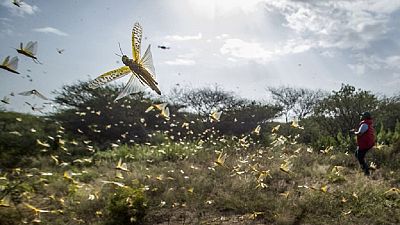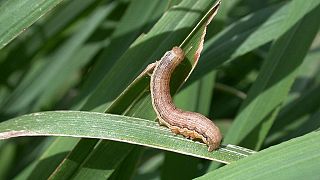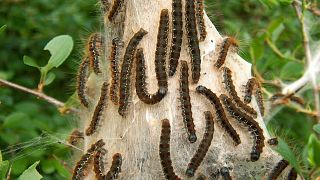Democratic Republic Of Congo
The United Nation’s Food and Agriculture Agency on Tuesday warned of a “major hunger threat” in East Africa, as a small group of desert locusts entered the Democratic Republic of Congo.
This is the first time the voracious insects have been seen in the Central African country since 1944.
Kenya, Somalia and Uganda have been battling the swarms in the worst locust outbreak that parts of East Africa have seen in 70 years. The U.N. said swarms have also been sighted in Djibouti, Eritrea and Tanzania and recently reached South Sudan, a country where roughly half the population already faces hunger after years of civil war.
A joint statement Tuesday from FAO director-general Qu Dongyu, U.N. humanitarian chief Mark Lowcock, and World Food Program Executive Director David Beasley called the swarms of locusts “a scourge of biblical proportions” and “a graphic and shocking reminder of this region’s vulnerability.”
The FAO said mature locusts, carried in part by the wind, arrived on the western shore of Lake Albert in eastern Congo on Friday near the town of Bunia. The country has not seen locusts for 75 years, it said.
“Needless to say the potential impact of locusts on a country still grappling with complex conflict, Ebola and measles outbreaks, high levels of displacement, and chronic food insecurity would be devastating,” the U.N. officials said in the joint statement.
Locust swarms can reach the size of major cities and can destroy crops and devastate pasture for animals.
Experts have warned that the outbreak is affecting millions of already vulnerable people across the region.
Resources need to combat locust scourge
Uganda’s government said Tuesday it was trying to contain a large swarm and will need more resources to control the infestation that has spread to over 20 districts in the north. Soldiers have been battling swarms using hand-held spray pumps, while experts have said aerial spraying is the only effective control.
The U.N. recently raised its aid appeal from $76 million to $138 million, saying the need for more help is urgent.
“This funding will ensure that activities to control the locusts can take place before new swarms emerge,” the U.N. officials said, noting that to date only $33 million has been received or committed.
Experts have warned that the number of locusts if unchecked could grow 500 times by June, when drier weather is expected in the region.
“WFP has estimated the cost of responding to the impact of locusts on food security alone to be at least 15 times higher than the cost of preventing the spread now,” the U.N. officials said in the statement.
A changing climate has contributed to this outbreak as a warming Indian Ocean means more powerful tropical cyclones hitting the region. A cyclone late last year in Somalia brought heavy rains that fed fresh vegetation to fuel the locusts that were carried in by the wind from the Arabian Peninsula.
Desert locusts have a reproduction cycle of three months, the U.N. officials said, and mature swarms are laying eggs in vast areas of Ethiopia, Kenya and Somalia, “many of which are already hatching.”
“In just a few weeks, the next generation of the pests will transition from their juvenile stage and take wing in a renewed frenzy of destructive swarm activity,” the joint statement said.
This is a time when farmers’ crops begin to sprout, which could devastate East Africa’s most important crop of the year, the U.N. officials said.
“But that doesn’t have to happen,” they said. “The window of opportunity is still open. The time to act is now.”
AP













01:01
Trial of DRC's former Justice Minister Constant Mutamba postponed for two weeks
01:45
Empowering youth in agriculture could boost global economy, FAO report says
02:08
Gunman attack in north-central Nigeria: death toll climbs to 150
00:08
Vatican beatifies Congolese customs worker killed in 2007 for refusing bribe
11:14
Rwanda Walks Away: what’s behind the Central Africa rift? [Business Africa]
01:49
UN warns of impact Sudan's humanitarian crisis is having on Chad